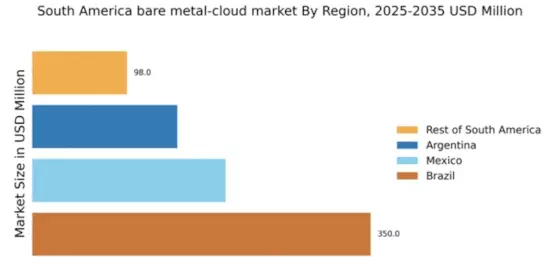Emergence of Hybrid IT Environments
The trend towards hybrid IT environments is gaining traction in South America, influencing the bare metal-cloud market. Organizations are increasingly adopting a combination of on-premises and cloud solutions to optimize their IT strategies. This hybrid approach allows businesses to leverage the benefits of both environments, such as scalability and control. As companies seek to integrate bare metal solutions into their hybrid architectures, the demand for dedicated resources is likely to rise. The bare metal-cloud market is poised to capitalize on this trend, as organizations look for reliable infrastructure to support their hybrid models. This shift is expected to drive innovation and investment in bare metal services, further enhancing market growth.
Increased Focus on Latency and Performance
In South America, the emphasis on low latency and high performance is becoming a pivotal driver for the bare metal-cloud market. Businesses are increasingly aware that latency can significantly impact user experience and operational efficiency. As a result, many organizations are opting for bare metal solutions that provide dedicated resources, ensuring optimal performance for critical applications. Recent studies indicate that companies utilizing bare metal solutions experience up to 40% lower latency compared to traditional cloud services. This performance advantage is particularly appealing to sectors such as gaming and streaming, where real-time responsiveness is essential. Consequently, the bare metal-cloud market is likely to see heightened demand as organizations prioritize performance in their IT strategies.
Regulatory Compliance and Data Sovereignty
The regulatory landscape in South America is evolving, with governments implementing stricter data protection laws. This shift is driving organizations to seek bare metal solutions that ensure compliance with local regulations. Data sovereignty concerns are particularly pronounced, as businesses must adhere to laws governing data storage and processing within national borders. The bare metal-cloud market is responding to this need by offering solutions that provide dedicated infrastructure, allowing companies to maintain control over their data. As a result, organizations are increasingly investing in bare metal services to mitigate compliance risks. The market is expected to grow as more businesses recognize the importance of aligning their IT infrastructure with regulatory requirements.
Rising Investment in Digital Transformation
Digital transformation initiatives are on the rise across South America, propelling the bare metal-cloud market forward. Organizations are increasingly investing in technology to enhance operational efficiency and customer engagement. This transformation often necessitates robust IT infrastructure, which bare metal solutions can provide. Recent reports suggest that companies in South America are expected to allocate over $10 billion towards digital transformation by 2027. As businesses seek to modernize their IT environments, the bare metal-cloud market is likely to benefit from increased demand for dedicated resources that support innovative applications and services. This investment trend indicates a promising future for the market as organizations prioritize technology-driven growth.
Growing Adoption of Cloud-Native Applications
The increasing adoption of cloud-native applications in South America is driving the bare metal-cloud market. Organizations are seeking to leverage the scalability and flexibility offered by cloud-native architectures. This trend is particularly evident in sectors such as finance and e-commerce, where rapid deployment and performance are critical. According to recent data, the cloud-native application market in South America is projected to grow at a CAGR of 25% through 2026. This growth is likely to enhance the demand for bare metal solutions, as businesses require dedicated resources to optimize application performance. The bare metal-cloud market is thus positioned to benefit from this shift, as companies look for robust infrastructure to support their cloud-native strategies.


















Leave a Comment